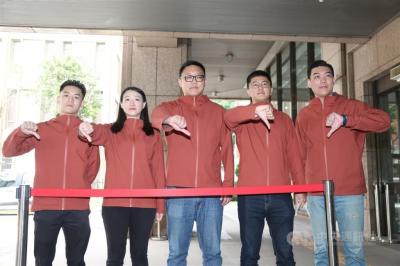The Taiwan Railways Administration (TRA) is next year to start changing some of its antiquated power facilities, with the cost of the four-year project expected to top NT$8 billion (US$280.30 million).
While the launch on Dec. 20 of electrified train services on the South Link Line — which was the nation’s last unelectrified railway line — marked a significant milestone, the agency yesterday said that some of its power facilities have reached the age of retirement after having been used for more than four decades.
The agency has been gradually retiring some of the high-risk power system facilities since 2015, it said.
As of the end of this year, it has changed 1,260km of main overhead wires, TRA electricity section chief Cheng Chih-ming (鄭志銘) said, adding that the new wires have increased structural tension by 22 percent and reduced the number of incidents caused by broken overhead wires.
The agency also increased the capacity of the transformers in nine of the substations along the line from 15 megavolt-amperes to 25 megavolt-amperes, Cheng said.
Workers’ ability to repair and maintain the wires have vastly improved through the use of 17 newly purchased overhead line maintenance vehicles, he added.
Cheng said the agency would spend NT$8 billion in the next four years to replace some of the critical infrastructure in its power system.
Traditional wires in the underground tunnel connecting New Taipei City’s Sijhih (汐止) and Fuchou (浮洲) railway stations — which stretches a total of 52km — would be replaced with conductor rail wires, he said.
The agency would also purchase two high-speed overhead line inspection vehicles, which can quickly convert collected information into quantitative data, he said.
“Our long-term goal is to develop an Internet-of-Things system to manage the facilities related to the railway system,” Cheng said. “Using a smart system would allow us to quickly locate a malfunctioning current transformer or a protective relay.”
“This would reduce our maintenance costs and enable us to run a safer and reliable train service,” he added.
Maintenance workers in the agency would also undergo training focused on life-cycle management systems for railway facilities, in which they would learn to better identify facilities that need replacement and propose changes, Cheng said.

Taiwan is stepping up plans to create self-sufficient supply chains for combat drones and increase foreign orders from the US to counter China’s numerical superiority, a defense official said on Saturday. Commenting on condition of anonymity, the official said the nation’s armed forces are in agreement with US Admiral Samuel Paparo’s assessment that Taiwan’s military must be prepared to turn the nation’s waters into a “hellscape” for the Chinese People’s Liberation Army (PLA). Paparo, the commander of the US Indo-Pacific Command, reiterated the concept during a Congressional hearing in Washington on Wednesday. He first coined the term in a security conference last

Prosecutors today declined to say who was questioned regarding alleged forgery on petitions to recall Democratic Progressive Party (DPP) legislators, after Chinese-language media earlier reported that members of the Chinese Nationalist Party (KMT) Youth League were brought in for questioning. The Ministry of Justice Investigation Bureau confirmed that two people had been questioned, but did not disclose any further information about the ongoing investigation. KMT Youth League members Lee Hsiao-liang (李孝亮) and Liu Szu-yin (劉思吟) — who are leading the effort to recall DPP caucus chief executive Rosalia Wu (吳思瑤) and Legislator Wu Pei-yi (吳沛憶) — both posted on Facebook saying: “I

The Ministry of Economic Affairs has fined Taobao NT$1.2 million (US$36,912) for advertisements that exceed its approved business scope, requiring the Chinese e-commerce platform to make corrections in the first half of this year or its license may be revoked. Lawmakers have called for stricter enforcement of Chinese e-commerce platforms and measures to prevent China from laundering its goods through Taiwan in response to US President Donald Trump’s heavy tariffs on China. The Legislative Yuan’s Finance Committee met today to discuss policies to prevent China from dumping goods in Taiwan, inviting government agencies to report. Democratic Progressive Party Legislator Kuo Kuo-wen (郭國文) said

The Ministry of Economic Affairs has fined Taobao NT$1.2 million (US$36,900) for advertisements that exceeded its approved business scope and ordered the Chinese e-commerce platform to make corrections in the first half of this year or its license would be revoked. Lawmakers have called for stricter supervision of Chinese e-commerce platforms and more stringent measures to prevent China from laundering its goods through Taiwan as US President Donald Trump’s administration cracks down on origin laundering. The legislature’s Finance Committee yesterday met to discuss policies to prevent China from dumping goods in Taiwan, inviting government agencies to report on the matter. Democratic Progressive Party